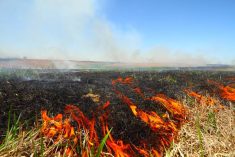Canadian Agricultural Injury Reporting recently released its latest report with data on agriculture-related fatalities between 1990 and 2020, with particular focus on 2011 to 2020. CAIR is a national surveillance program funded by the Canadian Agricultural Safety Association and co-ordinated by the Injury Prevention Centre at the University of Alberta.
According to the latest CAIR findings, from 1990 to 2020 there were 2,814 agriculture-related fatalities in Canada, an average of 91 deaths each year. However, when looking at figures between 2006 and 2020, the average number of fatalities drops to 70 per year.
That decrease offers a glimmer of good news for the industry, but the report makes it clear that agriculture still has a long way to go when it comes to farm safety.
Read Also

Moo translator and methane measures: There’s an app for that
Dalhousie University researchers use artificial intelligence to create new dairy farm apps that analyze cattle sounds and measure methane.
Of particular concern is the fatality rate for the 0-14 age group, said Don Voaklander, director of the Injury Prevention Centre and a professor of public health.
As the CAIR report notes, one of the unique aspects of agriculture is that farms and ranches are not just worksites but also places where people live. As a result, while other industries see victims of occupational injuries almost exclusively in the 18 to 65 age range, children account for a significant number of injuries in agriculture.
“It’s still distressing that the child fatality rate has not changed one iota in the 30 years of CAIR reports. It’s just flatline for fatality rates with kids and that’s the most disturbing part of the report,” said Voaklander, adding many of the deaths are the result of drownings and machine run-overs.
“It’s always more distressing when we haven’t changed behaviour around kids. While the mechanisms (of injury) have changed over the years, the rate of fatalities for kids hasn’t.”
However, there have been “significant gains” with older farmers, he added.
Though fatality rates are still the highest among older farmers, there has been a steady decline in fatalities for the 60 and over age group, with a statistically significant decrease of 1.8 per cent each year from 1990 to 2020. More modern farm equipment is the key factor.
“In anecdotal information, the older farmers, typically, when working on the farm take out the older equipment because they’re familiar with it” Voaklander said. “But a lot of that older equipment is coming out of service now, which has made a significant difference. The use of more modern equipment has certainly had an impact.”
While the decrease in fatalities is promising, it comes with a catch. The number has declined because the number of farmers dropped by half from 1990 to 2020 (a difference of 571,033 fewer people).
“The number of fatalities has decreased but that correlates with the number of farmers actively farming,” said Voaklander.
And farming remains one of the most hazardous occupations, ranking fourth overall and the most dangerous occupation “in terms of absolute numbers of fatalities.”
A primary reason for that is attitudes, he said.
“Agriculture, as an industry, hasn’t adopted a culture of safety,” Voaklander said. “One of the reasons the farming community is so unique is that it’s all about a culture of risk. ‘What insurance am I going to take out? What commodity am I going to produce? Is the weather going to be helpful to me this year?’
“Risk is an accepted part of the culture in agriculture and that’s really hard to change.”
Being aware of the hazards is critical. And while farmers and farm workers are well aware of the risks associated with rollovers and run-overs (the top two causes of fatalities), Voaklander said they are less aware of other hazards, such as drownings.
“Farms are full of dugouts and manure pits and stock tanks, and these are all drowning hazards, especially for kids on the farm,” he said.
“It comes down to that safety needs to be part of the everyday. Whenever something needs to be done, the thought process should be ‘what’s the safest way I should do this?’”
And that need to embrace farm safety as part of the everyday is tied to the overarching purpose of the CAIR data, which Voaklander said is intended to help “back up the position that farm safety is important.”
“That’s the importance of maintaining these reports, that it keeps the data front and centre. It underscores the issue and proves the importance of farm safety and that more needs to be done.”
The report can be found at casa-acsa.ca/en/cair/reports. The 35-page document has tables such as the top three causes of fatalities by season (page 13), the 10 leading causes of fatalities (page 15) and the top three causes of roll-overs and what task was being performed when they happened (page 18).















